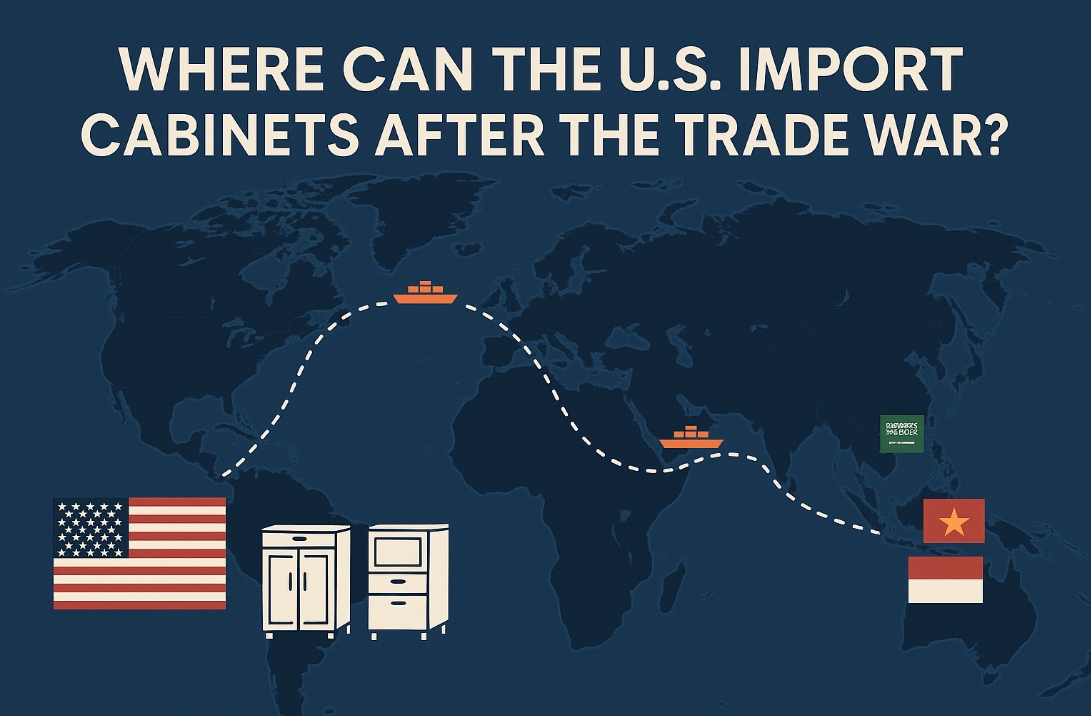Where Can the U.S. Import Cabinets After the Trade War?
- PA Home
1 | Why imports still matter
You might ask, “If duties top 250%, why not just build everything at home?” The answer lives in the numbers. U.S. cabinet demand will edge up to a projected 135 million units by 2028 while domestic factory output remains flat. Freedonia’s 2024 report sees only 1.1% annual capacity growth, far below owner–builder demand.
At the same time, NAHB says recent tariffs have added $10,900 to the average new home—and that figure does not include finished kitchen cabinets. Builders still need cost-effective, quick-ship options or risk blowing budgets.

2 | Three forces that keep imports in the game
- Price gaps – Ready-to-assemble (RTA) kitchen cabinets arriving in one flat-pack container still land 20-30 % below comparable U.S. semi-custom lines—even after moderate tariffs.
- Speed – A 200-unit multifamily order can leave Ho Chi Minh City Friday and clear Long Beach in under 30 days. Domestic lead-times sit at 10–16 weeks.
- Labor – U.S. millwork shops struggle to hire. Imports act like a pressure valve, shaving site labor hours because pre-cut components drop straight into assembly crews.
3 | Global sourcing map—who fills China’s shoes?
| Country | Why It Works | Watch-outs |
|---|---|---|
| Vietnam | Largest cabinet supplier since 2020; deep RTA expertise. | 46 % “reciprocal” tariff pending; strict “no-China-content” certificates.ReutersFurniture Today |
| Mexico | USMCA zero duty; 50 % jump in wood kitchen-furniture exports to $304 M. | Capacity ramp-up; inland freight spikes.Furniture Today |
| Canada | High-end custom; automatic TSCA/CARB compliance. | Labor costs; limited volume. |
| Indonesia | Strong solid-wood supply; courting U.S. to cut 32 % tariff. | Port congestion; policy still fluid.Reuters |
| Malaysia / Thailand | Low-cost PVC-wrap doors; seasoned RTA factories. | CBP probes on transshipping; extra paperwork. |
| Saudi Arabia & Gulf | 0 % MFN and no Section 301 duties; new automated plants (e.g., PA Home Riyadh). | Longer Red-Sea route; young supply base. |
4 | Country spotlights
4.1 Vietnam—RTA capital of the world
Vietnam kept the top export slot in furniture and logged an 11 % drop in wood-kitchen furniture in 2024 yet still eclipsed every rival—proof of its lead. Furniture Today notes that Chinese and Taiwanese investors keep enlarging Ho Chi Minh clusters, maintaining scale that competitors can’t match.
But Washington accuses Hanoi of helping China sidestep duties, hence a proposed 46 % surcharge. Hanoi’s fix? Crack down on transshipping and lobby for a softer 22–28 % range. Deal or no deal, buyers should demand BOM audits and photo evidence of local machining.
4.2 Mexico—near-shoring on steroids
Forget thirty-day ocean voyages. Flatbeds from Monterrey cross Laredo in 48 hours. Mexico’s wood-kitchen category jumped 50 % year-on-year after plant expansions in Coahuila and Jalisco. Tariff? Zero, thanks to USMCA.
Capacity is tight, so lock in slots six months ahead or pay rush premiums. Pair Mexican carcasses with U.S.-made doors to hit Buy America thresholds on federal-funded projects.
4.3 Canada—boutique but bulletproof
Canadian shops focus on full-access frameless lines, dovetail drawers, and low-VOC finishes. Lumber travels by rail; final cabinets truck south in days. Labor is pricey, yet customs-free entry plus green credentials justify higher invoices for luxury condos.
4.4 Indonesia—solid-wood specialist
Indonesia ships rubberwood face-frames and meranti panels at scale. Jakarta is negotiating tariff relief; until then, a provisional 32 % reciprocal duty applies. Secure delivered-duty-paid (DDP) quotes or build duty insurance into pro-formas.
4.5 Malaysia & Thailand—price kings with paperwork pain
Price still seduces multi-family developers, but CBP rulings show that one wrong plywood core can trigger 251 % China duties. Insist on third-party chain-of-custody audits and keep every invoice for five years.
4.6 Saudi Arabia—new kid with zero 301 risk
Vision 2030 money built fully automated lines outside Riyadh. MFN duty on wood cabinets is 0 %, and Section 301 doesn’t touch Gulf goods. Lead-time sits at 28–32 days via Red Sea. For big tract housing, the math can beat East Asia once you add China-plus duties.
5 | Four import plays that actually work
Think of sourcing like an investment portfolio—diversify, hedge, and track.
- Split orders: Place 60 % with Vietnam or Indonesia for price, 30 % with Mexico for speed, 10 % with Canada for high-end lots.
- Assemble stateside: Import flat parts from tariff-friendly zones, clip U.S. doors onsite, and sell as “substantially transformed” goods.
- Duty-drawback loops: Re-export unused inventory to Caribbean projects and reclaim Section 301 cash.
- Data vault: Keep digital packs—factory videos, wood species certs, HS codes—ready for any Customs knock.
6 | Key takeaways
Trade walls rise, but supply chains detour. By blending Vietnam kitchen cabinets for budget, Mexican kitchen cabinets for speed, and Canadian boutique cabinetry for prestige, U.S. developers still beat deadlines and keep budgets sane—even as kitchen cabinet tariffs hit headlines.
Looking for a one-stop partner that already straddles these regions? PA Home operates advanced Industry 4.0 cabinet factories in Indonesia and Saudi Arabia, offering duty-free shipping under MFN and fully complying with U.S. design specifications.



